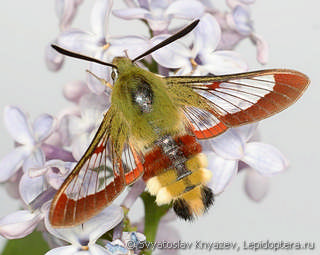Hemaris fuciformis

Taxonomy
class Insecta
Species name(s)
Hemaris fuciformis (Linnaeus, 1758) = Sphinx fuciformis Linnaeus, 1758 = Sphinx variegata Allioni, 1766 = bombyliformis (sensu Ochsenheimer, 1808) = Macroglossa milesiformis Treitschke, 1834 = Macroglossa lonicerae Zeller, 1869 = Macroglossa caprifolii Zeller, 1869 = Macroglossa robusta Alphéraky, 1882 = Hemaris simillima Moore, 1888 = heynei (Bartel, 1898) = circularis (Stephan, 1924) = Haemorrhagia fuciformis jordani Clark, 1927 = musculus Wagner, 1919 = rebeli Anger, 1919 = minor Lambillion, 1920 = obseleta Lambillion, 1920 = jakutana Derzhavets, 1984. [9, 10]
Broad-bordered Bee Hawk-moth.
urn:lsid:insecta.pro:taxonomy:2818
Expansion
This species marks on the maps: 1.
Zoogeographical regions
Palaearctic.
Russia regions
#1. Kaliningradsky; #3. Karelsky; #4. Evropeisky Severo-Zapadny; #7. Evropeisky yuzhno-tayozhny; #8. Evropeisky Tsentralny; #9. Evropeisky Tsentralno-Chernozyomny; #10. Sredne-Volzhsky; #11. Volgo-Donsky; #12. Nizhnevolzhsky*; #13. Zapadno-Kavkazsky; #14. Vostochno-Kavkazsky; #15. Severo-Uralsky; #16. Sredne-Uralsky; #17. Yuzhno-Uralsky; #19. Sredneobsky; #20. Yuzhno-Zapadnosibirsky; #22. Krasnoyarsky; #23. Predaltaisky; #24. Gorno-Altaisky; #25. Tuvinsky; #27. Pribaikalsky; #31. Yuzhno-Yakutsky; #33. Severo-Okhotomorsky; #37. Nizhne-Amursky; #38. Sakhalin; #40. Primorsky.
* An asterisk denotes a region for which the species is listed as an migrant or information that requires additional checking.
Forewing length
22—24 mm.
Primary colors
Yellow, Brown/Gray/Black.
Flight time
| January | February | March | April | May | June | July | August | September | October | November | December |
Larva lifespan
| January | February | March | April | May | June | July | August | September | October | November | December |
Detailed information with references
Distribution
Imago Habitus and Differences from alike species
General info about Imago
Imago lifespan
General info about Larva
Larva food plants / other food objects
Larva lifespan
Subspecies of Hemaris fuciformis
- Hemaris fuciformis affinis Bremer, 1861. [187]
- H. f. ganssuensis Grum-Grshimailo, 1891. [187]
- H. f. jordani Clark, 1927. [187]
- H. f. syra Daniel, 1939. [187]
Authors
Initial species uploading to the site: Peter Khramov.
Text data: Peter Khramov.
The species characteristics formalization: Peter Khramov.
References
- [1] O. Karsholt, J. Razowski (eds.), 1996. The Lepidoptera of Europe: a distributional checklist
- [3] Каталог чешуекрылых (Lepidoptera) России. Под ред. С. Ю. Синёва. СПб.; М.: Товарищество научных изданий КМК, 2008
- [5] Райххолф-Рим Х. Бабочки. М.: Астрель, 2002
- [9] Tree of Life (funet.fi), 2012
- [10] de Jong, Y.S.D.M. (ed.) (2011) Fauna Europaea version 2.4 (faunaeur.org)
- [28] Moths and Butterflies of Europe and North Africa (leps.it), 2012
- [187] Species 2000, http://www.sp2000.org
Comments
Note: you should have a Insecta.pro account to upload new topics and comments. Please, create an account or log in to add comments
Hemaris fuciformis photos



























All the photos of the species in large size
Please, create an account or log in to upload your photo








